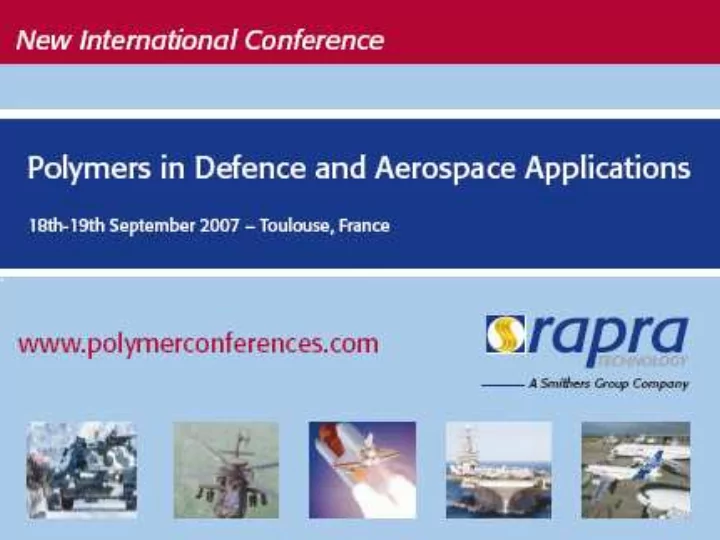

NYLON-12 NANOCOMPOSITE THIN FILMS AS PROTECTIVE BARRIERS by Dr. Cecilia L. Stevens, Polymer Engineering Company Dr. Marek J. Gnatowski, Polymer Engineering Company Dr. Scott Duncan, Defence Research and Development Canada
Concept product example Current technology Target technology
Thicknesses of barrier films: an evolution 25 µ m (0.025 mm) thin film 500 µ m (0.5 mm) 1990’s glove 1270 µ m (1.27 mm) 1980’s glove
Tortuous path theorem Tortuous path Exfoliated Platelets Polymer film L ⎟ ⎛ ⎞ τ = + ⎜ 1 V f ⎝ ⎠ 2 W
Equipment used for sample blending: potential differences in performance Single-screw extruder (SS) Batch blender (BB) Twin-screw extruder (TSE) Compounding twin-screw (D6/2)
Film casting
TEM images (1): Exfoliation issues BB SS
TEM images (2) D6/2 TSE
Platelet width: ‘ greater shear’ gives smaller platelets 210 Observed platelet width (nm) 190 170 150 130 110 90 BB SS D6/2 TSE Blending method
FTIR clay peak: greater shear gives a higher peak 1.2 1 FTIR Peak Height 0.8 0.6 0.4 0.2 0 BB SS D6/2 TSE Blending method
SSNMR: greater shear gives better dispersion H relaxation time and a lower T 1 420 410 T1H relaxation time (ms) 400 390 380 370 360 350 340 BB SS D6/2 TSE Blending method
Penetration and re-emission testing Nylon-12 had no detectable re-emission of sulphur mustard in 24 hours.
Penetration curves 6 5 Penetration (ug) 4 3 2 1 0 0 5 10 15 20 25 Time (h) 100% nylon-12 BB SS D6/2 TSE
Breakthrough time: strongly affected by exfoliation; not directly correlated to dispersion 16 14 Breakthrough time (h) 12 10 8 100% nylon 6 4 2 0 BB SS D6/2 TSE Blending method
Breakthrough time: dependent on clay loading 14 12 Breakthrough time (h) 10 8 6 4 2 0 0 2 4 6 8 10 Clay concentration (%)
Tensile strength: Not directly dependent on dispersion. 60 100% 50 nylon Yield stress (MPa) 40 30 20 10 0 BB SS D6/2 TSE Blending method *Apparent correlation to breakthrough time is deceptive.
Tensile strength: responsive to clay loading 54 52 Stress at yield (MPa) 50 48 46 44 42 40 0 2 4 6 8 10 Clay concentration (%)
Tensile Modulus (stiffness): Similar to tensile strength 1800 1600 1400 Modulus (MPa) 100% 1200 nylon 1000 800 600 400 200 0 BB SS D6/2 TSE Blending method
Tensile Modulus (stiffness): increases with clay loading 1600 1500 1400 Modulus (MPa) 1300 1200 1100 1000 900 800 700 600 0 2 4 6 8 10 Clay concentration (%)
Tear strength: Similar to tensile strength and modulus 100% 350.0 nylon 300.0 Tear strength (N/mm) MD 250.0 200.0 TD 150.0 100.0 50.0 0.0 BB SS D6/2 TSE Blending method Extrusion direction Transverse direction
Tear strength: increases slightly with clay loading 350 Tear strength (N/mm) 300 250 200 150 100 50 0 0 2 4 6 8 10 Clay concentration (%) Machine direction Transverse direction
Transparency 2.5% clay 5.0% clay 7.5% clay 10.0% clay
Conclusions � Nylon-12 is a suitable material for use in warfare agent barrier technology. � Montmorillonite nanoclay can greatly improve the barrier and mechanical properties of nylon-12 thin films. � Effective exfoliation and dispersion of the clay is critical to the film performance. � Dispersion, barrier properties, and mechanical properties are not directly related. � Optimal clay loading may be below 10%. � Optical transparency is excellent even at 10% clay loading
Acknowledgements PEC UBC SSNMR David Lesewick Colin Fyfe Beverley Start Richard Darton Kate Mao UBC TEM DRDC Kim Rensing Ben Lacroix Derrick Horne Garnet Martens W.C. Brabender Andrew Yacykewych
Recommend
More recommend